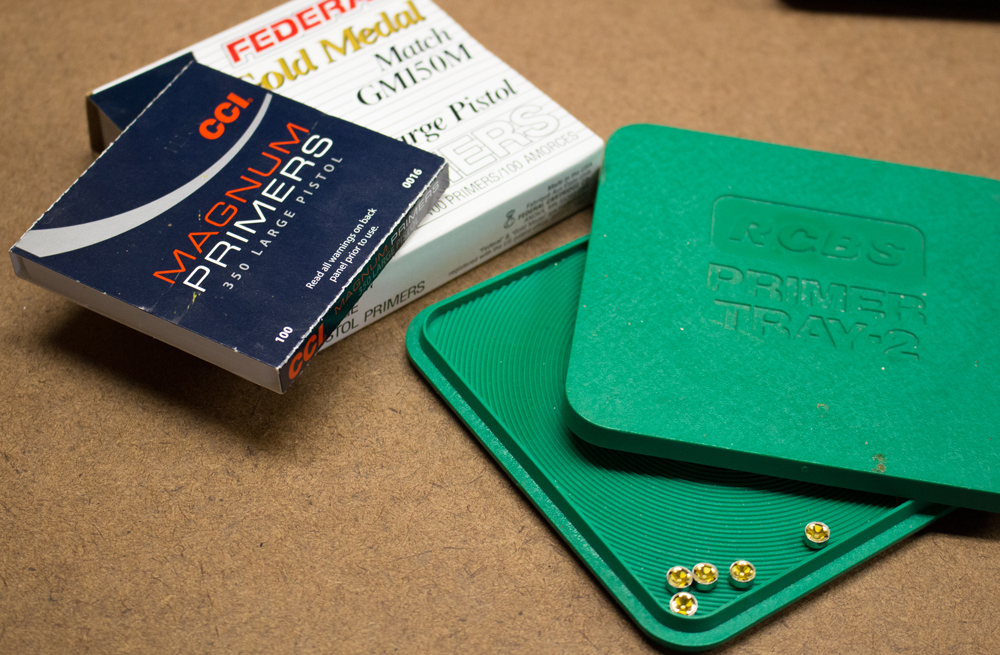

Don’t assume that all cartridge primers are the same. The way each is formulated means their performance can vary from manufacturer to manufacturer.
In the drought of the past two years, where reloading supplies have been limited, if not completely unavailable, we have been forced to make do with what we can obtain. We can save our cases, and cast our bullets, but cartridge primers and powder must be made to very specific formula.
Powder burn rates and charge weights are easily identifiable from our reloading manuals, but primers remain a bit of a mystery. Yes, it’s pretty easy to figure out that a large rifle magnum primer will burn a bit hotter than a large rifle primer, and the same correlation will apply to the other styles of primers, but what about between the different brands of the same class of primer?
This can be a tricky thing, as there is no easy way to measure primer heat, and no definitive listing of primer burn temperatures. However, in my experiments with different loadings, I can absolutely tell you that there is a difference in cartridge primer performance.
Using the large rifle primers as the example, mainly because that’s where I’ve found the largest discrepancies, switching primer brands in a particular load that is on the cusp of showing high pressure can easily push it over the edge.
Within the large rifle primers, I’ve found the Winchester WLR and Federal 210 to be the hottest, and the Remington 9 ½ to deliver the least heat, with the CCI200 somewhere in between. The generally accepted difference is heat is 6 percent, up and down from the middle ground CCI200, although that is subject to actual scientific data, which I’ve never seen.
Pistol cartridge primers are much less volatile, unless we’re talking about the big hunting cartridges, like the .454 Casull, .460 S&W and .500 S&W; I’d treat them with the same mindset as the rifle primers. However, it always pays to be safe and observe the rules I’m going to outline herein.
When the reloading components had all but dried up, loaders were grabbing anything they could get their hands on (myself included) and sometimes the primers that were available weren’t the brand I had used to develop an older load.
I remember the good folks at Beecroft’s Shooters Supply having to ‘ration’ primers, only selling as many primers to a customer to launch the amount of projectiles they purchased, in an effort to keep everyone shooting. Things being what they were, I had no choice but to use what I could get, but found some interesting results.
All that my pal Dave had available at Beecroft’s were Federal 210 primers, and I was loading for my .308 Winchester, for which I had usually used Remington 9 ½ primers. The idea of different primer heat niggled at my mind, so I (wisely, in retrospect) backed the powder charge down 1.5 grains, and headed to the range.

The hotter Federal primer gave the same velocity as the Remington, but with 1.5-grains less powder, indicating that the hotter spark is equal to an increase in pressure. This could be potentially dangerous if one were to simply swap out primers without considering the pressure increases; it would be the same principle as using a case with thicker walls.
Now that the market is starting to loosen up and components are becoming more readily available, do your best to find and store an ample supply of the primer that you’ve developed your pet load, and stick with that choice.
If the situation dictates that you must switch primers, play it safe and work up to your previous load slowly, reducing the powder charge to begin with, and slowly increase it, watching for pressure signs along the way.

Next Step: Get your FREE Printable Target Pack
Enhance your shooting precision with our 62 MOA Targets, perfect for rifles and handguns. Crafted in collaboration with Storm Tactical for accuracy and versatility.
Subscribe to the Gun Digest email newsletter and get your downloadable target pack sent straight to your inbox. Stay updated with the latest firearms info in the industry.

![Best Concealed Carry Guns In 2025 [Field Tested] Wilson Combat EDC X9S 1](https://gundigest.com/wp-content/uploads/Wilson-Combat-EDC-X9S-1-324x160.jpg)


![Best 9mm Carbine: Affordable PCCs [Tested] Ruger Carbine Shooting](https://gundigest.com/wp-content/uploads/Ruger-Carbine-Shooting-100x70.jpg)
![Best AR-15: Top Options Available Today [Field Tested] Harrington and Richardson PSA XM177E2 feature](https://gundigest.com/wp-content/uploads/Harrington-and-Richardson-PSA-XM177E2-feature-100x70.jpg)

Thanks for posting such amazing information!
https://meridian-firearms.com/product/federal-small-pistol-primers/